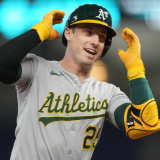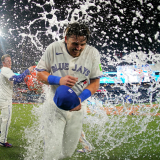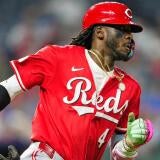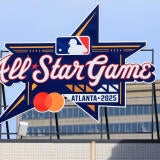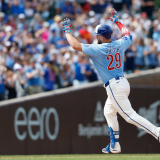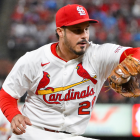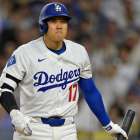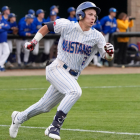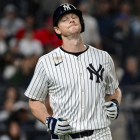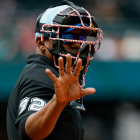
Jac Caglianone's elite strength puts him alongside Cal Raleigh, but is power enough for the Royals call-up?
The 2024 No. 6 draft pick is expected to make his MLB debut Tuesday
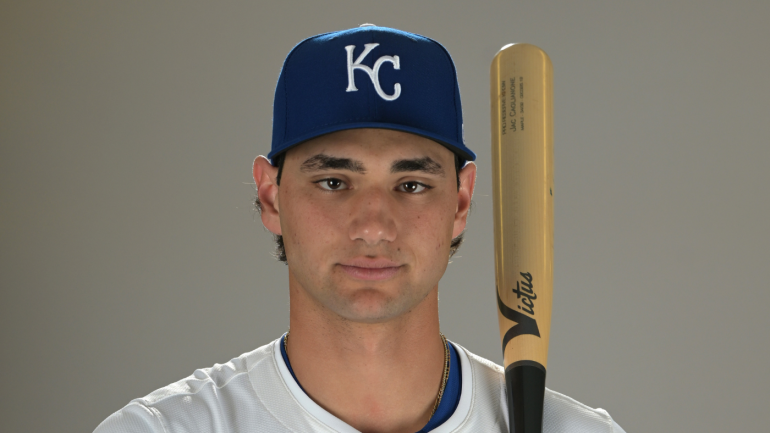
One of baseball's most interesting prospects will officially arrive on Tuesday night, when Kansas City Royals first baseman/outfielder Jac Caglianone will make his big-league debut against the St. Louis Cardinals (GameTracker). Caglianone is in the lineup, batting sixth and playing DH for the Royals. First pitch is scheduled for 7:45 p.m. ET.
It's been a quick ascent to The Show for Caglianone, who was drafted No. 6 overall just 11 months ago. He since earned placement on the fast track by hitting .322/.389/.593 with 15 home runs and nine additional extra-base hits in 50 games split across Double- and Triple-A. (Although he was drafted as a two-way player out of the University of Florida, he hasn't yet -- and likely won't ever -- pitch professionally.)
If you find yourself wanting to learn more about Caglianone before he takes his first big-league cuts, then consider this to be the proper destination. Below, I've provided three things worth knowing about the Royals' newest slugger, including how his power stacks up against some of the best hitters in the majors.
1. Elite raw strength
This is the natural place to start with Caglianone, who shattered Matt LaPorta's school record at Florida by homering 75 times in 165 games. He's also made a habit out of posting high-end exit velocities. Last year in the Arizona Fall League, Caglianone cleared 117 mph on a single. For perspective, only eight big-league players have toppled that threshold this season, and that group includes vaunted sluggers Elly De La Cruz, Aaron Judge, James Wood, and Shohei Ohtani. Earlier this year, he even toppled the 120 mph threshold.
4⃣6⃣4⃣FT
— Northwest Arkansas Naturals (@nwanaturals) April 6, 2025
1⃣1⃣6⃣ MPH@jac_caglianone has his first AA homer and it literally left the ballpark! pic.twitter.com/1BLkE2lqsc
Caglianone's Triple-A run saw him get up to only 113.6 mph. That would still put him in company with the likes of Matt Olson, Austin Riley, and Cal Raleigh, among other notables. Of course, there's more to analyzing a player's likely slugging output than just their maximum exit velocity. It's worth checking out how often the player is clearing 95 mph -- that way you get a better feel for the distribution of their contact quality -- and their average launch angle on balls hit that hard.
Here's a look at Caglianone stacks up compared to some of the other players we mentioned. (Do keep in mind that his numbers stem from a smaller sample against weaker competition, so it's an apples to orangutans comparison.)
| Player | Average EV | 95 mph+ % | 95 mph+ launch angle |
|---|---|---|---|
Caglianone (Triple-A) | 93.8 mph | 57.5% | 13.9 degrees |
Olson | 94.3 mph | 56.5% | 13.9 degrees |
Riley | 92.3 mph | 52.1% | 20.2 degrees |
Raleigh | 92.6 mph | 50% | 22.6 degrees |
As you can see, this selection of Caglianone's ball-tracking measures line up with what Olson has done this season, albeit against better competition. Considering that Olson is sporting a 120 OPS+ and is on pace for his fifth career 30-homer season, the Royals would take that outcome in a heartbeat. Alas, the comparison falls apart under closer examination.
2. Approach concerns
Caglianone was a highly accomplished collegiate hitter who thrived in the SEC -- college baseball's truest proving grounds -- and had both appreciable high-end power and barrel feel. Yet I knew teams who had him ranked lower than 10th on their preference lists entering last summer's draft because of the concerns they had about his plate approach.
Before diving into Caglianone, let's address the concept of "approach." The term is often thrown around to mean one of two things. The more common, more basic meaning is a stand-in for strike-zone judgement -- essentially, can the batter discern balls from strikes, or are they swinging at anything and everything, inside and out of the zone? The more advanced way of thinking about approach is to understand that every batter has their own optimal attack plan, and that it's crucial for the player to learn and implement theirs if they want to maximize their talent.
MLB's No. 10 prospect Jac Caglianone mashes his first Triple-A @OMAStormChasers roundtripper! ⚡️
— MLB Pipeline (@MLBPipeline) May 23, 2025
113.6 mph | 410 ft for the @Royals' top-ranked prospect. pic.twitter.com/FEiB61VeJt
Nowadays, teams employ statistical models to analyze a player's swing decisions. This is where Caglianone, for as productive and skilled as he is, gets docked. He's an aggressive hitter, one who is unafraid of expanding his strike zone, likely because of the confidence he has in finding his barrel. Let's take a look at some of his plate discipline numbers from his time in Triple-A:
| Split | Zone swing% | Chase% | Overall contact% | In-zone contact% |
|---|---|---|---|---|
Caglianone (Triple-A) | 78.8% | 34.4% | 73.8% | 86.6% |
MLB average | 66.2% | 27.3% | 75.8% | 83.6% |
Again, bear in mind that MLB hitters are facing a higher quality of pitching, so this isn't a perfect comparison. Caglianone's in-zone swing rate would rank fifth highest among MLB players with at least 100 plate appearances; his chase rate would rank 47th highest (out of 301); and his in-zone contact rate would tie him for 153rd. In other words, Caglianone would indeed be one of the most aggressive swingers in the majors even if his rates maintain with the promotion.
The good news for the Royals, I suppose, is that they've seen this profile work at the big-league level before. Just to add a little more context, here are those metrics again for Caglianone, and for his new Royals teammates Salvador Perez and Bobby Witt Jr.:
| Split | Zone swing% | Chase% | Overall contact% | In-zone contact% |
|---|---|---|---|---|
Caglianone (Triple-A) | 78.8% | 34.4% | 73.8% | 86.6% |
Perez | 75.9% | 42.5% | 75.3% | 87.2% |
Witt Jr. | 71.1% | 32.5% | 78% | 86% |
Witt has developed into one of the best players in the majors, a perennial Most Valuable Player Award contender. Perez, unfortunately, is in the midst of his worst season as a big-league player. He remains on the sunny side of the league-average line for his career, however, and from 2020-24 he posted a 116 OPS+ while averaging 35 home runs per 162 games.
3. Where he fits
You might find yourself wondering where, precisely, Caglianone fits into the Royals lineup. After all, he's mostly played first base over the last few years, and the Royals already employ Vinnie Pasquantino at the cold corner. The answer seems to be on the outfield grass. Caglianone had started seeing action in right field as early as late April. He's since made more regular appearances there as of late, including a few looks in left field to improve his optionality.
The Royals can use all the offensive help they can get at this stage of the season -- especially from the outfield. Kansas City's outfielders collectively rank 29th in OPS, just ahead of the Cleveland Guardians. Not a single one of the Royals' regular outfielders has an individual OPS+ above 100, with only Kyle Isbel and Drew Waters even breaking the 90 mark.
Caglianone, then, doesn't have to necessarily develop into the Royals' version of Yordan Alvarez to represent a big upgrade -- and, potentially, a big boon to Kansas City's playoff chances.
![[object Object] Logo](https://sportshub.cbsistatic.com/i/2020/04/22/e9ceb731-8b3f-4c60-98fe-090ab66a2997/screen-shot-2020-04-22-at-11-04-56-am.png)



